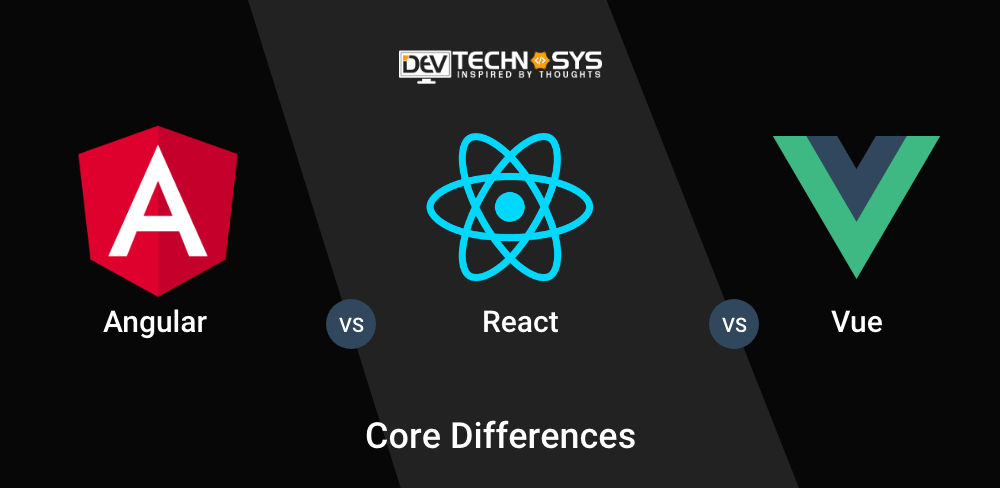Web developers are constantly having to make decisions between a variety of development frameworks and select one for their project. So, how to choose a framework between Angular vs React vs Vue for your next significant project is a topic of frequent discussion among developers. These are some of the frameworks that have gained popularity among developers and are creating the conundrum.
The fact that Vue is a progressive framework and React is a UI library distinguishes these three. On the other hand, Angular is a full-featured front-end framework. According to the StackOverflow Survey 2022, the three frameworks that developers use the most are React, Angular, and Vue.
The intention of this article is to explain the difference between Angular vs React vs Vue, the requirement of frameworks, the varied functionality of the frameworks, and guide you regarding which would suit your business the best.
What is Angular?
Angular is a TypeScript based open framework for Single Page Applications, developed and maintained by Google. AngularJS version 2 was originally to be Angular. AngularJS apps can easily migrate to Angular 2 because of the architectural choices made by Google, such as the lack of backwards compatibility.
Angular is distributed under the MIT license. Angular is a framework that offers developers a standard framework with which to work. It also has many advantages. Users can create large apps in an easy to manage way.
What is React?
Jordan Walke is a Facebook software developer who introduced React to the world in 2011. React is JavaScript with a component based approach for building declarative user interfaces. It can be used to manage the view layer for web and mobile applications. React’s primary goals are to be easy, fast, declarative, comprehensive, and adaptable.
React is a library and not a framework. React is a library that only renders user interfaces. This leaves much to the individual application. The stack is the term commonly used to describe a collection of tools that are typically required to develop an application with ReactJS. Additionally, you must hire dedicated developers in order to build a web app with the React technology for your business.
What is Vue?
Vue, a JavaScript framework, is used to build single-page apps (SPAs) as well as user interfaces. Vue.js, like all the others, is open-source and free. The architectural design pattern is called Model-view viewmodel (MVVM).
Evan You created the framework in 2014. It is a direct outcome of his experience using AngularJS at Google. You wanted to create a framework that was lightweight and retained the features of AngularJS he liked.
MVVM allows the separation of the business logic or model from the graphical interface or view. The difference is a simple pattern for both front-end and rear-end developers. The viewmodel is the framework that separates these issues and acts as a link.
Angular vs React vs Vue–Advantages
In this section, we will discuss the advantages of Angular vs React vs Vue frameworks. So let’s have a look:
Advantages of Angular
- Full-Featured Framework:
A complete collection of tools and functionalities are offered by the comprehensive framework Angular, which may be used to create complex applications.
It offers built-in support for components, data binding, dependency injection, routing, forms handling, and more. Utilizing a variety of libraries and tools to create sophisticated applications takes time and effort, which our integrated method eliminates.
- TypeScript Integration:
TypeScript, a statically typed superset of JavaScript, is used to create Angular. TypeScript brings enhanced tooling, static type checking, and improved code maintainability to Angular projects. It helps catch errors during development and provides better editor support for autocompletion, refactoring, and code navigation.
- Powerful Data Binding:
The two-way data binding feature of Angular makes it easier to synchronize data between the model and the display. Every time the underlying model is changed, it automatically updates the view, and vice versa.
This declarative approach reduces boilerplate code and enables developers to focus on the application’s logic rather than manual data manipulation.
Advantages of React
- Component-Based Architecture:
React is a component-based methodology in which the user interface is divided up into manageable, reusable components. Each element maintains its own state and may be used to create intricate user interfaces.
The application’s UI hierarchy is also simpler to manage and reason about because of its modularity, which also encourages code reusability and streamlines maintenance.
- Virtual DOM:
A virtual DOM (Document Object Model) is used by React to quickly update and render UI components. React creates a minimal representation of the DOM in memory rather than modifying it directly.
React finds the bare minimum set of updates needed to update the UI and applies them in an efficient way by comparing the virtual DOM with the actual DOM. This strategy results in enhanced performance and quicker UI refreshes.
- JSX:
The JSX (JavaScript XML) syntax extension, which mixes JavaScript and HTML-like code, is a syntactic extension that developers may use to create components in React. JSX offers a declarative and simple method for describing the organization and operation of UI components.
It makes it possible for JavaScript code to utilize a familiar HTML syntax, which makes it simpler for developers to comprehend, visualize, and manage the UI hierarchy.
Advantages of Vue
- Approachable and Easy to Learn:
The syntax and API of Vue are intended to be simple and understandable, making it simple for developers to understand and use right away. The gradual learning curve of Vue allows developers to gradually adopt it into existing projects or learn it from scratch without feeling overwhelmed. Because of its easy learning curve, both novice and seasoned developers may use it.
- Flexible and Versatile:
Vue offers a high level of flexibility and allows developers to adopt it incrementally. It can be used for small, single-page applications or scaled up to develop complex, large-scale applications.
Vue can be integrated into existing projects easily, allowing developers to leverage its features in specific parts of an application without rewriting the entire codebase.
- Component-Based Architecture:
Vue has a component-based design, similar to React, in which the user interface is broken up into reusable components. Because each component has its own logic, template, and styles, managing and maintaining the codebase is made simpler. The ease with which components may be reused, combined, and nested within one another encourages the modularity and reuse of code.
Angular vs React vs Vue–Disadvantages
Now that you know the advantages of Angular vs React vs Vue, we will now learn the disadvantages of this.
Disadvantages of Angular
- Steep Learning Curve:
The learning curve for Angular is severe, especially for those who are unfamiliar with the framework or have little background in JavaScript or TypeScript. The framework has a large set of concepts, terminologies, and best practices to understand, which can be overwhelming for beginners.
- Complexity:
A robust framework with a variety of features and functionalities, Angular. While this can be advantageous for complex applications, it also adds to the overall complexity of the framework. Particularly when they increase in size and complexity, Angular apps may become complicated and challenging to manage.
- Performance Overhead:
Angular applications can have a higher performance overhead compared to lighter frameworks or libraries. The framework relies on a complex architecture and additional layers of abstraction, which can impact the initial loading time and overall performance of the application, especially on low-end devices or slow network connections.
Disadvantages of React
- High Learning Curve:
React has a challenging learning curve, particularly for those who are unfamiliar with the toolkit or have no background in front-end and JavaScript programming. React introduces concepts like JSX, virtual DOM, and component-based architecture, which may take time to grasp for beginners.
- Boilerplate Code:
React focuses on the “View” layer of the application, which means that additional libraries and tools are required to build a complete application. As a result, setting up a React project often involves configuring build tools, managing state, and handling routing separately, leading to a certain amount of boilerplate code.
- Lack of Opinionated Structure:
Since React is a library and not a complete framework, it does not impose any particular coding conventions or provide a tight organizational structure.
While this flexibility can be an advantage, it can also result in inconsistent project structures and varying approaches among developers, making it harder for newcomers to navigate and contribute to projects.
Disadvantages of Vue
- Smaller Ecosystem:
Compared to other popular frameworks like React or Angular, Vue has a smaller ecosystem. While Vue has a dedicated and active community, it may have a more limited selection of third-party libraries, plugins, and community-generated resources. This can make it slightly more challenging to find specific solutions or components for certain requirements.
- Learning Curve for Advanced Features:
Vue’s core library is relatively easy to learn and has a gentle learning curve. However, as you delve into more advanced features, such as the Composition API or Vuex for state management, the learning curve can become steeper. Mastering these advanced features and understanding their optimal use requires additional time and effort.
- Limited Corporate Backing:
Vue.js is an open-source project primarily maintained by a small team of core contributors and volunteers. While this can be a positive aspect in terms of community involvement, it also means that Vue may have comparatively less corporate backing or financial resources compared to frameworks supported by large tech companies. This can affect the pace of development, tooling, and long-term sustainability.
Angular vs React vs Vue–Key Difference
As per angularJS development company, below are the key differences between Angular vs React vs Vue that you must take into consideration before choosing one for developing a website.
| Feature | Angular | React | Vue |
| Language | TypeScript | JavaScript | JavaScript |
| Learning Curve | Steeper | Moderate | Gentle |
| Rendering | Server-side and Client-side | Client-side | Client-side |
| Component Structure | Hierarchical | Component-based | Component-based |
| Size | Larger | Smaller | Smaller |
| Performance | Good | Excellent | Excellent |
| Flexibility | Opinionated | Highly flexible | Moderately flexible |
| Data Binding | Two-way and One-way | One-way | Two-way and One-way |
| Community Support | Large and Active | Large and Active | Growing and Active |
| Popularity | Widely used | Widely used | Increasingly popular |
| Official Documentation | Extensive and Detailed | Extensive and Detailed | Extensive and Detailed |
| Ecosystem | Full-featured | Robust and Extensive | Growing and Extensive |
| Tooling | Comprehensive | Varies | Comprehensive |
| Dependency Management | Built-in (Angular CLI) | External (Webpack, Parcel, etc.) | Built-in (Vue CLI) |
Angular vs React vs Vue-Detailed Comparison
Angular, React, and Vue are three popular JavaScript frameworks used for building web applications. Despite the fact that they all have the same overall function, they all differ greatly in terms of their architecture, functionality, and level of community support. Here’s a detailed comparison of Angular, React, and Vue given by react native development company:
1. Architecture:
Angular: Angular is a complete, opinionated framework developed and maintained by Google. It follows the Model-View-Controller (MVC) architecture, where components define the structure, behavior, and appearance of different parts of the application.
React: React is a JavaScript library developed by Facebook. It follows a component-based architecture, where reusable UI components manage their own state and are composed to build the application’s user interface.
Vue: Developed by Evan You, Vue is a progressive framework. Similar to React, it uses a component-based architecture, but with an emphasis on usability and simplicity.
2. Learning Curve:
Angular: Due to its broad feature set, complicated ideas like dependency injection, and usage of TypeScript as the default language, Angular has a higher learning curve than React and Vue.
React: React has a relatively easy learning curve, especially if you’re familiar with JavaScript. It has a smaller API surface area and focuses on composing reusable UI components.
Vue: Vue has the gentlest learning curve among the three. Its syntax is intuitive and easy to grasp, and it provides clear documentation and gradual adoption, allowing developers to use Vue in existing projects.
3. Language:
Angular: The primary scripting language used by Angular is TypeScript, a statically typed superset of JavaScript that offers extra capabilities including static typing and sophisticated tool support.
React: React’s primary language is JavaScript (ES6+), while it may also be utilized with TypeScript if so desired.
Vue: Developers have the option of using JavaScript or TypeScript with Vue, allowing them to utilize their favorite language.
4. Community and Ecosystem:
Angular: A sizable and vibrant community exists for Angular, and Google is a major supporter. It has a comprehensive ecosystem, including tools, libraries, and well-established best practices.
React: React has one of the largest and most vibrant communities. It benefits from Facebook’s support and has a rich ecosystem with numerous third-party libraries and tools available.
Vue: Vue has experienced significant growth in its community and adoption. While its ecosystem may not be as extensive as Angular or React, it still offers a wide range of libraries and tools to support development.
5. Performance:
Angular: Angular’s performance is generally good, thanks to its highly optimized change detection mechanism. However, its bundle size tends to be larger compared to React and Vue, which may impact initial loading times.
React: React’s virtual DOM diffing algorithm makes it efficient in updating only the necessary components, resulting in good performance. It has a smaller bundle size compared to Angular.
Vue: Vue’s performance is similar to React, as it also uses a virtual DOM and efficient rendering mechanisms. It has a small bundle size, making it lightweight and fast.
6. Popularity and Industry Adoption:
Angular: Angular has been around for a longer time and has a solid presence in enterprise and large-scale applications. It is widely adopted by companies like Google, Microsoft, IBM, and many more.
React: React’s popularity has skyrocketed in recent years, and it has become the de facto choice for many web developers. Numerous businesses, like Facebook, Instagram, Airbnb, Netflix, and others use it.
Vue: Vue has gained significant popularity and adoption in the web development community. It is used by companies such as Xiaomi, Alibaba, Xiaomi, Baidu, and Laravel.
Conclusion
Each of the three has advantages over the others: Vue is straightforward and very effective, React is adaptable and speedy. However, the sort of framework or library you require for your company totally depends on the needs of your company and the goals you have for your web application. The best way to go about this would be to hire Vue developers on board and explain in detail, Angular vs React vs Vue, what you want out of the app.
























